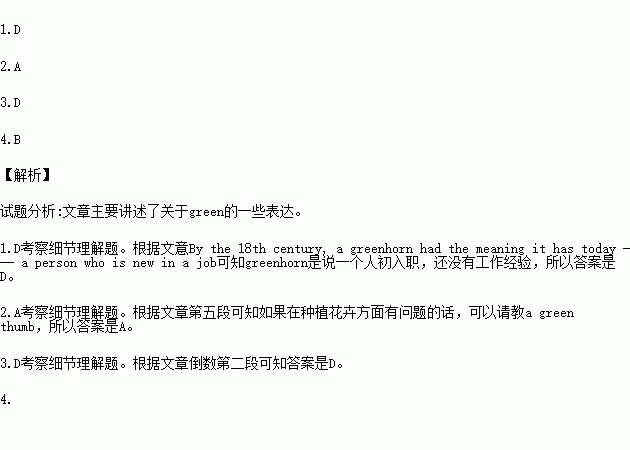题目内容
Green is an important color in nature. It is the color of grass and the leaves on trees. It is also the color of most growing plants.
Sometimes, the word green means young, fresh and growing. Sometimes, it describes something that is not yet ripe(成熟的) or finished.
For example, a greenhorn is someone who has no experience, who is new to a situation. In the 15th century, a greenhorn was a young cow or ox whose horns(角) had not yet developed. A century or so later, a greenhorn was a soldier who had not yet had any experience in battle. By the 18th century, a greenhorn had the meaning it has today --- a person who is new in a job.
About 100 years ago, greenhorn was a popular expression in the American west. Old-timers used it to describe a man who had just arrived from one of the big cities back east. The greenhorn lacked the skills he would need to live in the west.
Someone who has the ability to grow plants well is said to have a green thumb. The expression comes from the early 1900s. A person with a green thumb seems to have a magic touch that makes plants grow quickly and well. You might say that the woman next door has a green thumb if her garden continues to grow long after your plants have died.
Green is also the color used to describe the powerful emotion, jealousy(嫉妒). The green-eyed monster is not a frightening creature from outer space. It is an expression used about four hundred years ago by British writer William Shakespeare in his play "Othello."
It describes the unpleasant feeling that a person has when someone has something that he wants. A young man may suffer from the green-eyed monster if his girlfriend begins going out with someone else. Or, that green-eyed monster may affect your friend if you get a pay raise and she does not.
In most places in the world, a green light is a signal to move ahead. A green light on a traffic signal means your car can continue on. In everyday speech, a green light means approval to continue with a project.
1.If a person was a greenhorn, he might ___________.
A. be good at growing plants
B. get along well with others
C. be a soldier in the 16th century
D. have no experience in doing something
2.When you have trouble in growing flowers, you can ask for help from ___________.
A. a green thumb B. a green light
C. a greenhorn D. a green-eyed monster
3.If a girl refuses your invitation to a dance party but accepting another gentleman’s, you may___________.
A. need to buy a green light
B. have to get a green thumb
C. show them your greenhorn
D. be affected by the green-eyed monster
4.What is the passage mainly about?
A. The origin of the word “green ”.
B. Some expressions concerning green.
C. The story of a green-eyed monster.
D. Some ways of how to use words properly.
 轻巧夺冠周测月考直通名校系列答案
轻巧夺冠周测月考直通名校系列答案
